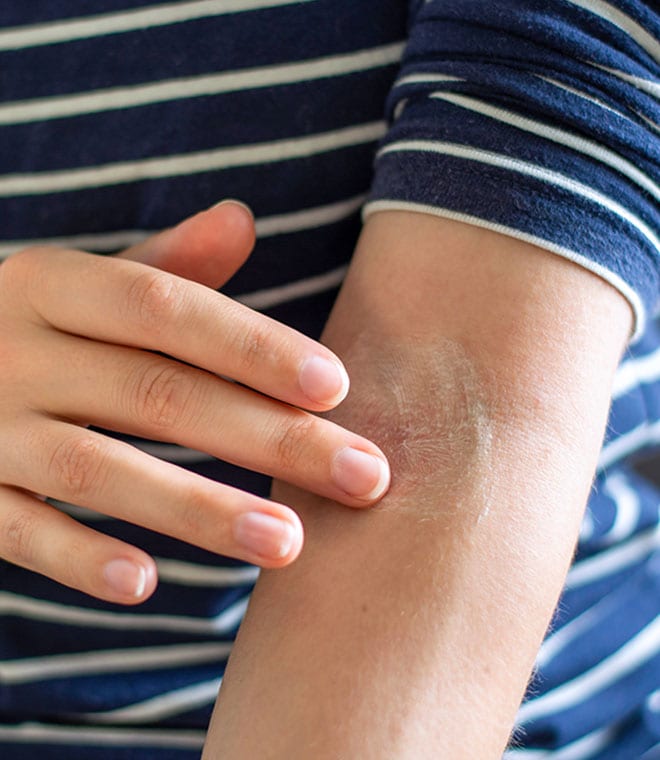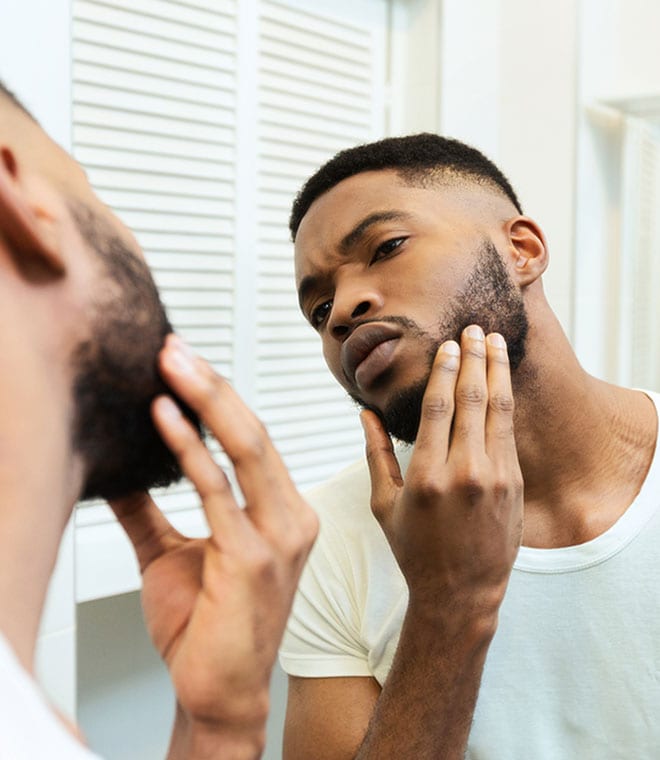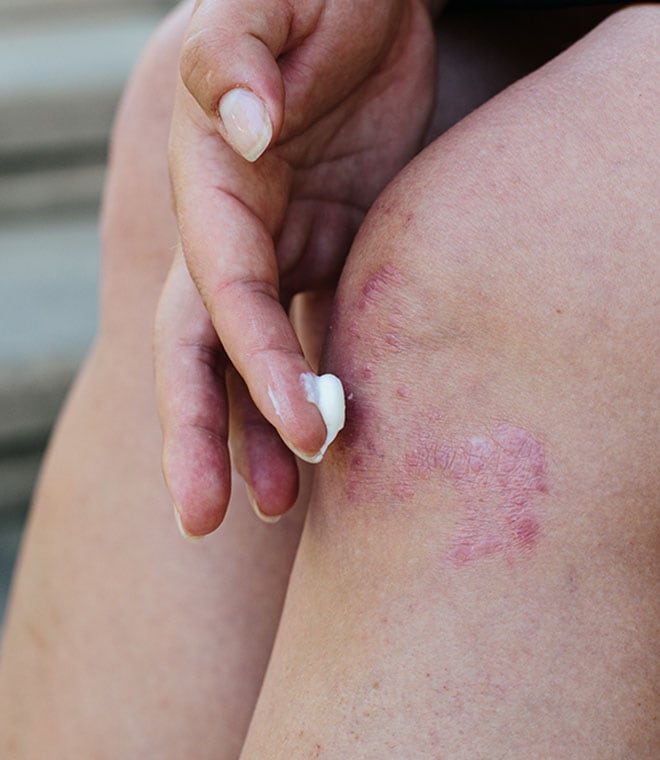Health
What are some common skin rashes and how to spot them
By Jenilee Matz, MPH Dec 18, 2023 • 6 min
Skin rashes may be painful, itchy or just unsightly, and they can stem from many causes. A skin rash can be caused by a variety of factors, such as exposure to allergens, skin conditions like psoriasis or a sensitivity to sunlight.
Allergy skin rash
Skin allergy rashes can develop when you come into contact with an allergen — a substance you're allergic to. There are several different types of allergy rashes, including:
- Hives, also called urticaria, can be caused by an allergy, such as to medication or food. Hives are welts that can vary in size from very small to as large as a plate, and they can appear anywhere on your body. They are itchy and red in color, but turn white in the center when you press on them. A hive only lasts for about 24 hours, but as old hives fade, new ones can appear. It's common for a single bout of hives to last up to six weeks, which is called acute hives. When hives last longer than six weeks, they are considered chronic hives.
- Atopic dermatitis, the most common form of eczema, often starts in childhood and sometimes improves or goes way with age. People with eczema are more likely to also have asthma and seasonal allergies. Eczema is a chronic, inflammatory skin reaction that likely occurs in response to an irritant or allergen, such as pollen, animals or foods. Eczema symptoms include irritated, dry, red and itchy skin. If the skin becomes infected, the rash may have small, fluid-filled bumps that ooze a clear or yellow liquid. The rash often appears on the face, inside the elbows, behind the knees and on the hands and feet.
- Contact dermatitis is a rash that develops after your skin comes into contact with an allergen or irritant. Symptoms of contact dermatitis include skin redness, itching, burning, swelling and blistering. The rash can appear right away, or it may take days or weeks after contact with the allergen or irritant to show up.
Psoriasis
In psoriasis, skin cells grow at an unusually fast rate. This causes a buildup of red, raised and scaly lesions on the skin. The rash can develop anywhere on the body, but it commonly affects the outside of the elbows, knees and scalp. It isn't known exactly what causes psoriasis, but the immune system and genetics are thought to play a role. In many cases, stress or changes in the weather can trigger psoriasis to flare up, and while there are several types of psoriasis, none of them is contagious.
Rash caused by the sun
Photosensitivity, more commonly known as sun allergy, is a term used to describe a sensitivity to the sun's ultraviolet (UV) light, causing red bumps to form on the skin. Several conditions can cause a skin reaction to the sun, with the most common being polymorphic light eruption (sun poisoning). Certain medications, health conditions and chemicals can also make skin more sensitive to the sun and increase the risk of a sun allergy rash. Sun allergy symptoms can vary depending upon the cause of the reaction and only appear on areas of skin that have been exposed to the sun. You may develop a sun rash on your arms if you spend time outside in a tank top, for example. Symptoms on the skin can include:
- Redness
- Itching
- Pain
- Small bumps that may form raised patches
- Blisters or hives
- Crusting, scaling or bleeding
Sun sensitivity symptoms often start within minutes or hours of sun exposure. The details on how to treat sun rash vary depending on what's causing your sun allergy. If you had a mild reaction, staying out of the sun for a few days may be enough to clear your symptoms.
Bacterial, viral or fungal rash
Some rashes are caused by bacteria, viruses or a fungus, and they can be contagious. Bacterial or fungal rashes likely need treatment by a healthcare provider. You should also be careful not to spread these infections to other people. Some potentially infectious rashes include:
· Impetigo- a bacterial infection that presents as red sores that turn into blisters oozing a crust over the rash area.
· Shingles- a viral illness that usually affects one side of the body with a painful blister-like rash.
· Viral illnesses, such as chickenpox, measles, roseola, rubella, hand-foot-mouth disease, fifth disease and scarlet fever, often cause skin rashes.
Your healthcare provider can determine the cause of your rash and recommend appropriate skin rash treatments.
When to see your healthcare provider
Skin rashes have many causes. Contact your healthcare provider if you have a rash that:
- Covers your body
- Starts suddenly and spreads quickly
- Is painful
- Begins to blister
- Comes with a fever
- Looks infected: A rash can become infected if you scratch it. Symptoms of infection include swelling, crusting, pain and warmth, a red streak, or yellow or green fluid coming from the rash.
Your healthcare provider can determine the cause of your rash and recommend appropriate skin rash treatments.
Clinically reviewed and updated by Julie McDaniel, MSN, RN, CRNI December 2023.
Sources:
- https://acaai.org/allergies/types/skin-allergies
- https://www.healthychildren.org/English/health-issues/conditions/skin/Pages/Common-Summertime-Skin-Rashes-in-Children.aspx
- https://www.mayoclinic.org/diseases-conditions/sun-allergy/symptoms-causes/syc-20378077
- https://www.aad.org/public/kids/skin/eczema/what-is-eczema
- https://www.psoriasis.org/about-psoriasis
- https://www.aad.org/public/diseases/eczema/contact-dermatitis
- https://www.aad.org/public/diseases/itchy-skin/hives
- https://medlineplus.gov/eczema.html
- https://nationaleczema.org/eczema/types-of-eczema/
- https://www.aad.org/public/diseases/rashes/rash-in-adults
- https://www.niams.nih.gov/health-topics/atopic-dermatitis
- https://www.mayoclinic.org/diseases-conditions/contact-dermatitis/symptoms-causes/syc-20352742
- https://www.merckmanuals.com/home/skin-disorders/sunlight-and-skin-damage/photosensitivity-reactions
- https://www.pennmedicine.org/for-patients-and-visitors/patient-information/conditions-treated-a-to-z/rash




